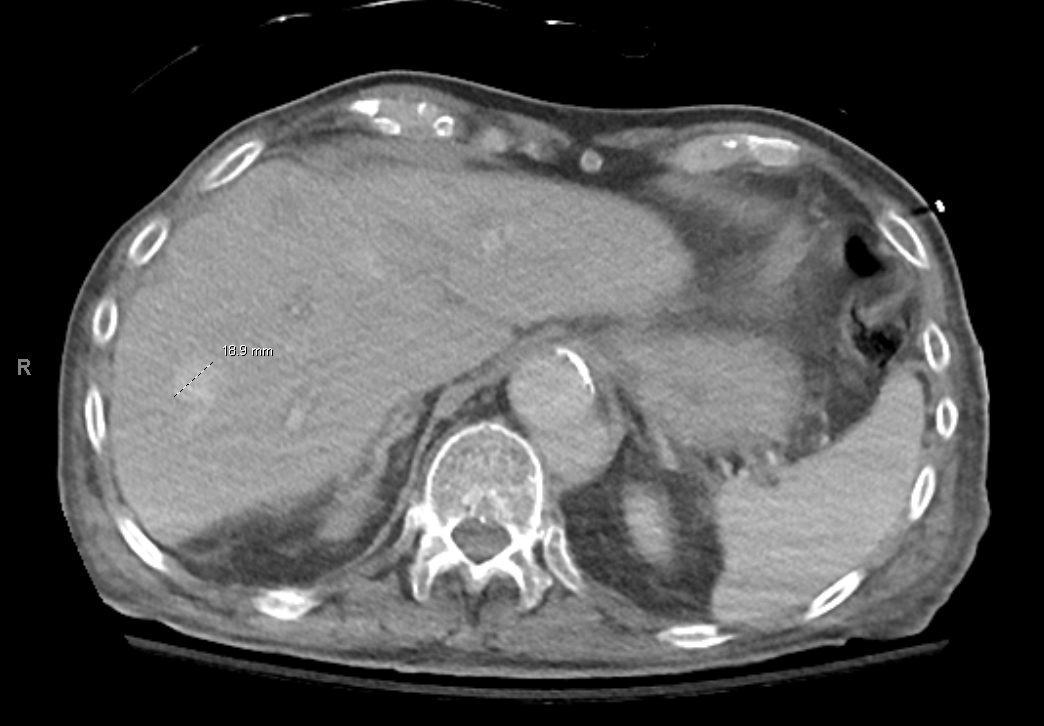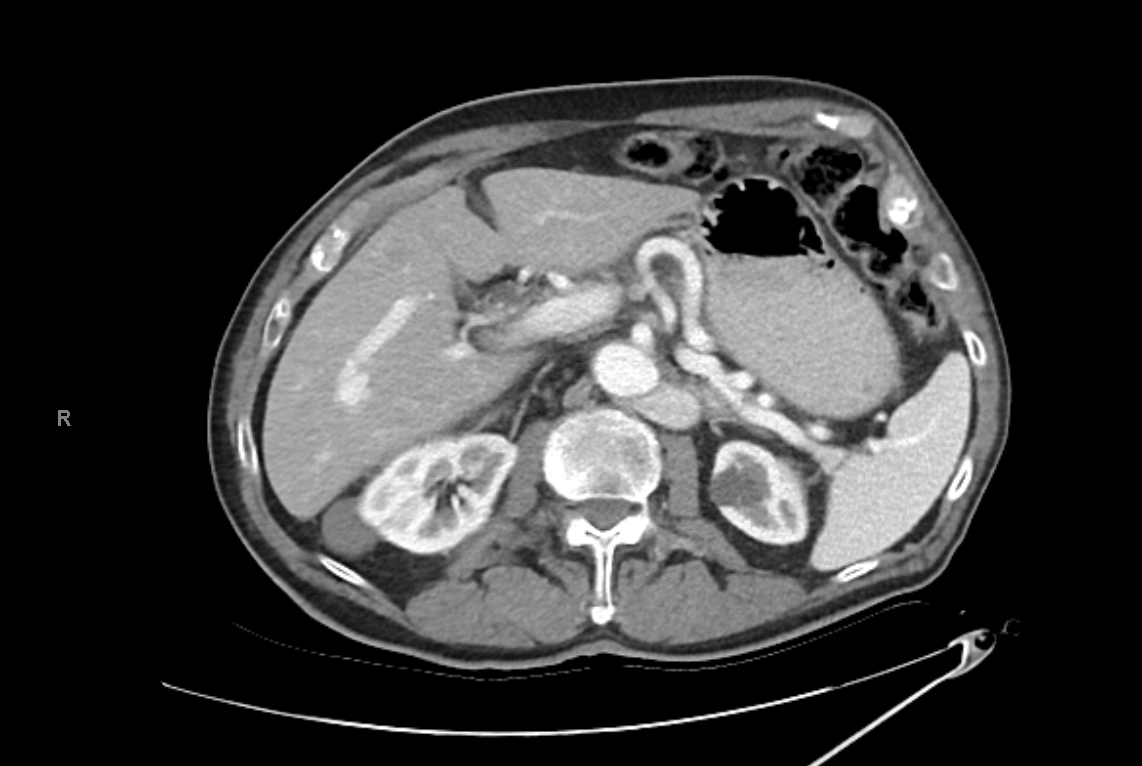Monday Poster Session
Category: Liver
P3892 - A Case of Asymptomatic Spontaneous Intrahepatic Portosystemic Shunt
Monday, October 27, 2025
10:30 AM - 4:00 PM PDT
Location: Exhibit Hall

Karol Suchowiecki, MD
University of Connecticut Health Center
Farmington, CT
Presenting Author(s)
Karol Suchowiecki, MD1, Karthik Mathialagan, MD2, Roopjeet Bath, MBBS3
1University of Connecticut Health Center, Farmington, CT; 2University of Connecticut, Farmington, CT; 3University of Connecticut Health, Farmington, CT
Introduction: A spontaneous intrahepatic portosystemic venous shunt (IPSVS) is a rare vascular malformation that can either be a congenital malformation during embryogenesis or acquired from trauma, liver biopsy, or chronic portal hypertension. In adults, IPSVS are usually asymptomatic, but rarely present with symptoms such as hepatic encephalopathy, hyperammonemia, and cholestasis. We present a case of a presumed congenital IPSVS that was incidentally discovered during workup for elevated liver enzymes.
Case Description/
Methods: A 90-year-old man with a history of recurrent UTIs was admitted after presenting with encephalopathy, hyperbilirubinemia/elevated liver enzymes (total bilirubin 4.9, direct bilirubin 3.8, AST 97, ALT 60, ALP 375) consistent with cholestatic liver injury. He had an extensive liver disease workup, which was negative for biliary obstruction, viral hepatitis including HAV, HBV, HCV, EBV, CMV as well as PBC, PSC, AIH, A1AT deficiency, Hemochromatosis, and Wilson’s Disease; there was no evidence of cirrhosis. He had no history of significant alcohol use. He was diagnosed with drug-induced liver injury given recent treatment with ceftriaxone and Bactrim for UTI. Antibiotics were discontinued on admission. His encephalopathy resolved without further intervention. Imaging was notable for a 19mm IPSVS in the right hepatic lobe. It was considered whether this could be contributing to this patient’s clinical picture; however, on further review it was noted that this shunt was present on prior imaging spanning several years and hence most likely congenital and not clinically significant in this patient’s case.
Discussion: Congenital portosystemic shunts can be intrahepatic or extrahepatic. While both types can cause neonatal cholestasis, hyperammonemia, and encephalopathy, extrahepatic shunts are almost always symptomatic, and require treatment due to the high risk of complications. Intrahepatic shunts can close spontaneously in the first years of life or persist until adulthood, when they are often discovered incidentally. Management of IPSVS is individualized based on shunt anatomy, size, and symptom burden. In asymptomatic patients, IPSVS should be closely followed with assessment of shunt anatomy with periodic imaging. In this patient, the IPSVS was stable on multiple CT scans over a many years, thus no further follow-up was recommended. Endovascular or surgical closure of IPSVS is reserved for patients with hyperammonemia, hepatic encephalopathy, liver dysfunction, or other complications.

Figure: Figure 1: CT Abdomen w IV contrast showing 18.9mm intrahepatic portosystemic shunt.

Figure: Figure 2: CT Abdomen w IV contrast showing 17mm intrahepatic portosystemic shunt four years prior to CT image in Figure 1.
Disclosures:
Karol Suchowiecki indicated no relevant financial relationships.
Karthik Mathialagan indicated no relevant financial relationships.
Roopjeet Bath indicated no relevant financial relationships.
Karol Suchowiecki, MD1, Karthik Mathialagan, MD2, Roopjeet Bath, MBBS3. P3892 - A Case of Asymptomatic Spontaneous Intrahepatic Portosystemic Shunt, ACG 2025 Annual Scientific Meeting Abstracts. Phoenix, AZ: American College of Gastroenterology.
1University of Connecticut Health Center, Farmington, CT; 2University of Connecticut, Farmington, CT; 3University of Connecticut Health, Farmington, CT
Introduction: A spontaneous intrahepatic portosystemic venous shunt (IPSVS) is a rare vascular malformation that can either be a congenital malformation during embryogenesis or acquired from trauma, liver biopsy, or chronic portal hypertension. In adults, IPSVS are usually asymptomatic, but rarely present with symptoms such as hepatic encephalopathy, hyperammonemia, and cholestasis. We present a case of a presumed congenital IPSVS that was incidentally discovered during workup for elevated liver enzymes.
Case Description/
Methods: A 90-year-old man with a history of recurrent UTIs was admitted after presenting with encephalopathy, hyperbilirubinemia/elevated liver enzymes (total bilirubin 4.9, direct bilirubin 3.8, AST 97, ALT 60, ALP 375) consistent with cholestatic liver injury. He had an extensive liver disease workup, which was negative for biliary obstruction, viral hepatitis including HAV, HBV, HCV, EBV, CMV as well as PBC, PSC, AIH, A1AT deficiency, Hemochromatosis, and Wilson’s Disease; there was no evidence of cirrhosis. He had no history of significant alcohol use. He was diagnosed with drug-induced liver injury given recent treatment with ceftriaxone and Bactrim for UTI. Antibiotics were discontinued on admission. His encephalopathy resolved without further intervention. Imaging was notable for a 19mm IPSVS in the right hepatic lobe. It was considered whether this could be contributing to this patient’s clinical picture; however, on further review it was noted that this shunt was present on prior imaging spanning several years and hence most likely congenital and not clinically significant in this patient’s case.
Discussion: Congenital portosystemic shunts can be intrahepatic or extrahepatic. While both types can cause neonatal cholestasis, hyperammonemia, and encephalopathy, extrahepatic shunts are almost always symptomatic, and require treatment due to the high risk of complications. Intrahepatic shunts can close spontaneously in the first years of life or persist until adulthood, when they are often discovered incidentally. Management of IPSVS is individualized based on shunt anatomy, size, and symptom burden. In asymptomatic patients, IPSVS should be closely followed with assessment of shunt anatomy with periodic imaging. In this patient, the IPSVS was stable on multiple CT scans over a many years, thus no further follow-up was recommended. Endovascular or surgical closure of IPSVS is reserved for patients with hyperammonemia, hepatic encephalopathy, liver dysfunction, or other complications.

Figure: Figure 1: CT Abdomen w IV contrast showing 18.9mm intrahepatic portosystemic shunt.

Figure: Figure 2: CT Abdomen w IV contrast showing 17mm intrahepatic portosystemic shunt four years prior to CT image in Figure 1.
Disclosures:
Karol Suchowiecki indicated no relevant financial relationships.
Karthik Mathialagan indicated no relevant financial relationships.
Roopjeet Bath indicated no relevant financial relationships.
Karol Suchowiecki, MD1, Karthik Mathialagan, MD2, Roopjeet Bath, MBBS3. P3892 - A Case of Asymptomatic Spontaneous Intrahepatic Portosystemic Shunt, ACG 2025 Annual Scientific Meeting Abstracts. Phoenix, AZ: American College of Gastroenterology.
